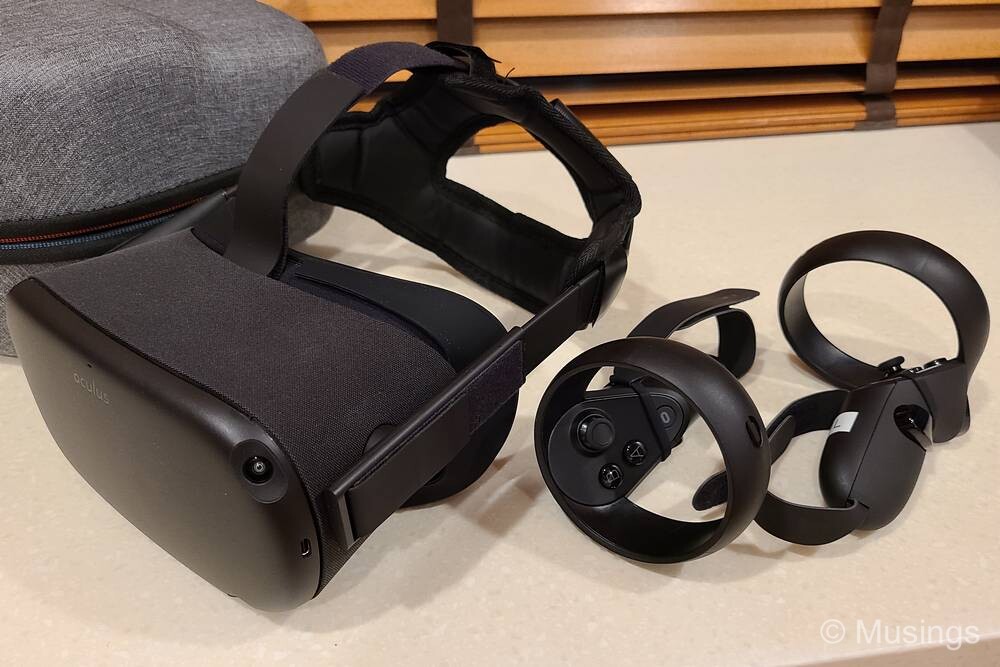My first comments two weeks into the Oculus Quest!
Setting up the Quest and pairing it to my Samsung Galaxy S20+ was easy and worked without a hitch, as did also the Windows app to enable Oculus Link. The Oculus app on Google Play seems to get updated frequently, and you can manage and observe various aspects of the headset itself through the mobile app, including battery levels for the headset and controllers. Oddly, I couldn’t get the iOS version of the app on my iPad Pro 11 to pair with the Quest. Specifically, the device doesn’t get recognized via Bluetooth. From comments online, the Quest can be paired to multiple devices, and I wanted to pair it also with the iPad Pro to provide a larger display for casting. But so far no luck on that one then.
The Quest does feel somewhat front-heavy, but the straps do a pretty good job of balancing the weight on your head so that it doesn’t drop off too much. Key to this is to tighten the top and side straps so that the headset can sit firmly on the head. A more serious consideration though is that one perspires easily when you’re intensely engaged – movement-wise specifically – in content. The thick foam layer around the circumference of the visor area is comfortable, but will easily absorb your sweat, and there will be a lot of it. That foam layer can be detached yes, but it probably can’t be easily washed. So, the first thing that many headset owners acquire is a washable layer that either replaces the manufacturer supplied foam layer, or sits on top of it. I picked up a cheap silicon piece for this off Amazon.
The headset’s two PenTile OLED 72 Hz displays are definitely improved over my old Samsung Gear VR’s, but the quality of visuals is still finally app-dependent. Some of the older stuff – e.g. the Jurassic Park demo which uses live video for a mostly non-interactive experience – looks pixelated, while the modern 3D rendered titles – e.g. Vader Immortal – looks fine. Either way, the visuals will not be as crisp as what you’d get from traditional non-VR gaming on the PC, but I reckon this is finally a limitation of how much processing power the headset has.
There’s thankfully no screen-door effect on the Visuals – something that was apparent on the Samsung Gear VR. The maximum refresh rate of 72Hz, which is significantly lower than headsets like the Valve Index or HTC Vive at 144 and 90Hz respectively. But those are also significantly more expensive, and enthusiasts have varying opinions on how much better is the experience at these higher refresh rates. For me at least, the Quest’s 72Hz is perfectly fine.
The Quest’s built-in speakers also do a decent job at projecting audio into my ears. The maximum volume is somewhat low though. It’s clear enough yes, but I have to keep the volume at maximum volume all the time for me to hear audio without straining. The benefit of using the headset’s built-in speakers is of course being able to hear peripheral sounds around you (e.g. the kids joining in when I’m also casting), but it also significantly reduces immersion. I’ve got a set of in-ear headphones for the Quest coming from Amazon SG, so will report in on those if I do a follow-up post in the next few months.
The set doesn’t come with a case, which I assume is to keep costs down. You’d definitely want one, as the headset is fairly large and not uniformly shaped. Amazon has a number of cases which can be had for around SGD25 to SGD30. I picked one up for SGD28, and it does exactly what it’s supposed to: it holds the headset, two controllers, Oculus charging cable, and also a few spare AA batteries. There are larger cases which I might look into if I acquire even more accessories for the Quest, but the basic case works great as a start.
Casting presents a usable video stream on my S20+ – when it works! Roughly one out of four times, casting doesn’t start, which necessitates having to retry again. But the video stream is otherwise smooth and fluid, though compression artifacts are obvious in the stream. Casting is a pretty crucial feature in VR headsets, as it permits a basic level of involvement between player and others in the same room – and also lets me advise our kids what to do in various parts of the content they’re at when using the Quest.
The Guardian feature in Oculus Quest is extremely useful, and the warnings come up quickly when you’re near the edge of the boundary you’ve defined. There’s also an option to disable the visual warnings too in case you’re really stationery, seated and in a large space – and there’s no chance you’d smack your hands into something.

My next post will cover apps and content I’ve tried out on the Quest!
Recent comments